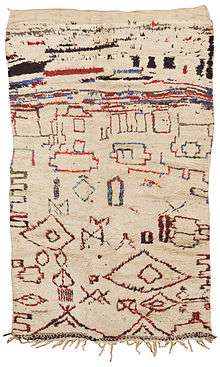Moroccan rugs

Moroccan rugs are the weaves, carpets, and textiles that have been traditionally hand-woven in Morocco. Rugs have been woven by the indigenous people of Morocco since the Paleolithic Era. Traditionally, Moroccan rugs have been woven by tribal peoples for their utility rather than for decorative purposes. Twentieth-century Moroccan rugs are widely collected in the West, and are almost always woven by tribes people who do not seek nor possess formal artistic training.
History

In the historic area encompassing the modern nation of Morocco, the tradition of rug-making is just about as old as it is anywhere in the world. The early adoption of rug-making by native Moroccans is certainly due in large part to the distinctive climate of the region: Moroccan rugs may be very thick with a heavy pile, making them useful for the snow-capped Atlas Mountains; or they may be flat woven and light as to suit the hot climate of the Sahara desert.[1] The nomadic Moroccans and Berber tribes used these pile, knotted, and flat-woven carpets as bed coverings and sleeping mats, as well as for self-adornment, and burial shrouds. Some of these rugs were also used for as saddle blankets. The designs that most frequently appear in Moroccan rugs are traditional and ancient, passed down from weaver to weaver.
Elsewhere in Morocco, most major cities have a unique style or design characteristic that distinguishes their carpets. Perhaps the most important carpet-producing city in Morocco is the long time Moroccan capital, Fes. Fes reached its golden age during the Marinid Dynasty of the thirteenth century. At that point, the city was home to over one hundred dye workers and thousands of artisan embroidery studios located in the city's medina. The coastal capital, Rabat, is famous for carpets woven with floral and diamond-shaped elements, and a fairly bare field.
Moroccan rugs experienced a growth in popularity in the West with mid-century modern designers – such as Le Corbusier – who paired the thick piled Berber rugs with their sleekly designed furniture. Many of these Berber carpets are woven by the Beni Ourain peoples from the Rif Mountains near Taza. Colors vary from neutral shades to popping hues, with designs ranging from ordered geometric shapes to a more free-form, expressive pattern. Part of the appeal to the modernists was the primitivism in the carpets. Unlike the traditional antique Oriental rugs found in Western interior decoration, there is little elegance about these rugs, yet they fit wonderfully with modernist décor. Vintage and antique Moroccan rugs are fairly popular today for their decorative flexibility and reasonable pricing as compared to other styles of antique rugs.
-

Example of Beni Ourain rugs, which are generally dichromatic and tribal in design.
-

Example of Berber rugs, among the most well-known and widely collected Moroccan rug varieties.
-

Moroccan rugs often feature design elements that border on the abstract.
-

This colorful rug showcases the proclivity of Moroccan weavers to utilize bright hues.
References
- ↑ Moroccan Carpets by Brooke Pickering
- Woven (Home&Lifestyle): exclusive seller of Moroccan Rugs in Northern Ireland.
- Sovereign Carpets: Unknown Masterpieces from European Collections By E. Concaro, A. Levi
- Berber Carpets of Morocco. The Symbols. Origin and Meaning By Bruno Barbatti
- Ait Bou Ichaouen: Weavings of a Nomadic Berber Tribe Alfred H. Saulniers, Suzanne S. Saulniers
- Nazmiyal Collection: Moroccan Rugs History & Selection